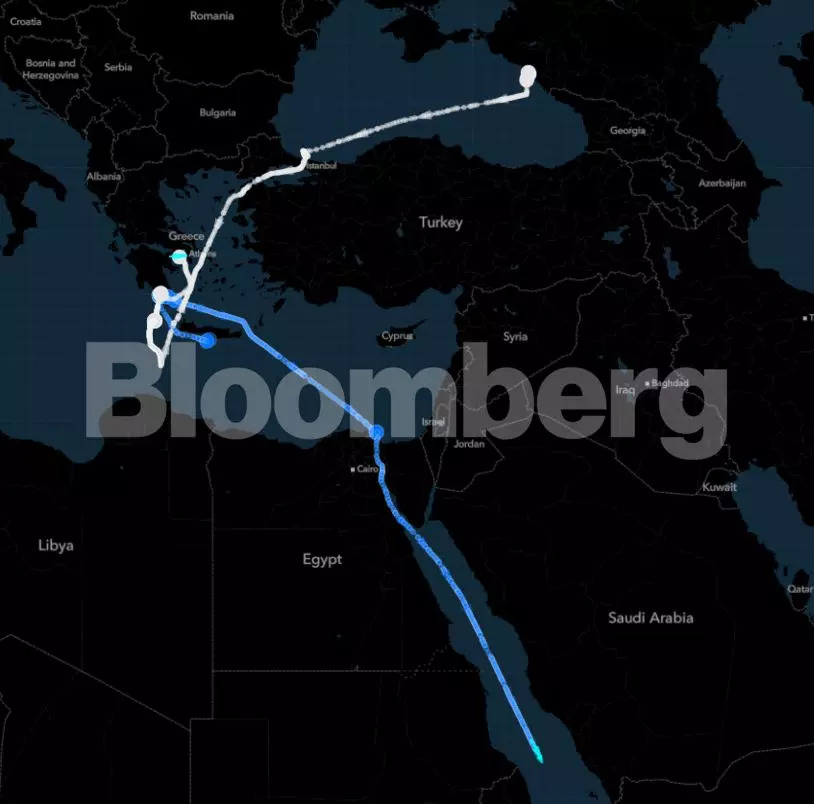Russia is likely to ship more fuel to Asia and the Middle East in the coming months as Europe tightens sanctions to step up its response to the invasion of Ukraine.
The two regions have already been taking a greater share of Russian exports since the war broke out, according to data from S&P Global Commodities at Sea, highlighting the as-yet-unfinished reconfiguration of global energy flows. Now, the European Union is set to bar most imports of Russian crude from Dec. 5, followed by a prohibition on oil products that’ll kick in from February, ramping up the pressure on Moscow to redirect more of its energy output.
India and China took a combined 2.7 million barrels a day of Russian crude and products last month, according to Morgan Stanley, 54% higher than a year earlier. Smaller nations, dubbed the rest of the world, boosted imports to 926,000 barrels a day from 561,000, the bank said in a recent note. China’s spending on Russian energy products hit a record $8.3 billion in August, customs data show.
While buyers in some nations such as Myanmar or Sri Lanka have acknowledged taking Russian cargoes as the war drags on, others have been more circumspect. As the trade continues to evolve, Russian sellers have been employing a variety of tactics to develop existing markets as well as find new outlets, including re-exports and ship-to-ship transfers. An uptick in flows may spur competition, hurting prices and undermining refining margins.
Here’s a look at what’s been happening in the trade, and what may come next.
1. Rebranding Cargoes
One way Russian products such as fuel oil can make their way into Asia is flowing through the region’s major distribution hubs. Such places typically have large land or floating storage facilities and can blend Russian fuels with other products before they are relabeled with a new origin and shipped onward.
“Sanctioned material has been flying under the radar and entering trading hubs for a long time, but this is going to accelerate as Russian sanctions come in,” said John Driscoll, director of JTD Energy Services, based in Singapore. “New grades and sources may emerge. One sign may be when exports far exceed the production of the country,” he said.
Ship-tracking data from Vortexa Ltd. shows a substantial increase in loadings of Russian fuel oil that have signaled destinations in the Middle East and Asia. Cargoes bound for the United Arab Emirates -- where Fujairah is located -- jumped by nearly five times last month compared with a year ago, while those signaling Singapore gained 25%. Shipments for Egypt, China, Saudi Arabia and Malaysia have also risen sharply.
2. Ship-to-Ship Transfers
As the fresh EU sanctions kick in, some buyers may not want to be seen taking Russian fuels, likely driving an increase in ship-to-ship transfers. In what’s a common method of obscuring trade flows, a first vessel loads a cargo from Russia, offloads it to a second, which sails to the final destination.
Some 20%-23% of the Russian naphtha, diesel and fuel oil loaded from west Russian ports in June to August was transferred by this method before heading to buyers, according to Serena Huang, lead Asia analyst at Vortexa.

In one recent example, medium-range tanker Sea Pride loaded high-sulfur fuel oil from Tuapse, Russia at the end of August, then transferred it to larger Suezmax vessel Kriti Breeze in Kalamata, Greece, according to Vortexa and Bloomberg data. The latter is signaling Zhoushan, China as its destination.
3. Emerging Nations
With many EU states shunning Russian products and crude and curbs set to tighten, the push by Moscow to find alternatives will become more acute, potentially targeting Sri Lanka, Pakistan, Myanmar and Indonesia. Some of these poorer nations are already struggling to pay for increasingly costly fuel imports, making the lure of cheaper Russian shipments difficult to resist.
In Indonesia, Southeast Asia’s largest economy, there have been talks this month between state oil company Pertamina and Russia on the possibility of increased flows. “The intention is there, the details need to be worked out,” Russian Ambassador to Indonesia Lyudmila Vorobieva said in early September.
Rather than take products at this stage, Pertamina plans to process Russian oil at its Balongan refinery, which is being revamped to be more flexible and use any type of crude, President Director Nicke Widyawati told the Jakarta Globe.
4. Stored at Sea
While the flow of Russian fuels is set to pick up, there’s a possibility Asia can’t fully digest all the excess, contributing to lower prices and a rise in volumes stored at sea, especially as slowing economic growth may dent demand.
Local markets for naphtha and high-sulfur fuel oil, HSFO, are already oversupplied, in part due to an influx of Russian products. Highlighting that situation, the prompt timespread for HSFO is in contango, a bearish structure in which later-delivered cargoes cost more. That offers sellers an incentive to store fuel for later sale.
The volume of Russian crude and oil products being stored at sea worldwide swelled to 5.67 million barrels as of Sept. 11, up from 2.9 million barrels at the start of the year, according to Kpler data.
“We expect a continued build up in Russian products on the water,” said



No comments:
Post a Comment